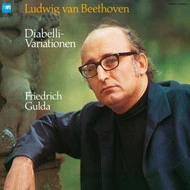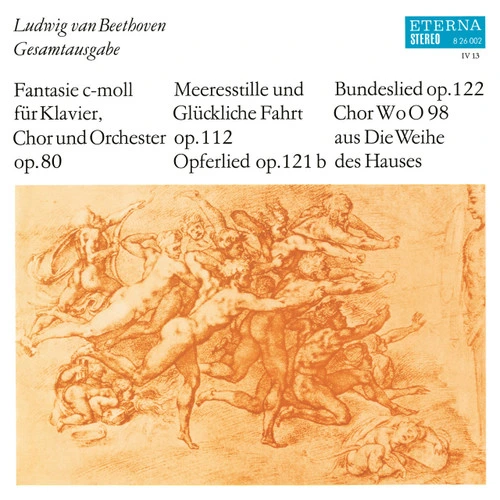Release Date To Be Announced pre-order your copy today!
Master Quality Reel To Reel Tape!
This item not eligible for any further discount offers!
Each Reel-To-Reel Tape is made to order and is typically here within 2-4 weeks!
In the course of his Diabelli Variationen, Beethoven directs old and new streams of music history into a single unique point of crystallization - combining the strict horizontal Baroque mode of composition such as is encountered in fugues with the vertical thinking of the Classical era, which found its paradigm in sonata form - and at the same time he challenges every article of faith and boldly anticipates the freedom of the Romantic age.
A cycle of extremes, stark contrasts and drama, as if written especially for Friedrich Gulda: the punk pianist who always defied convention, positively manic in the way he plunged his hands into the depths of a work and delivered new auditory experiences. Gulda, a lover of fast cars, drove straight into the cliff faces of interpretation with a consistency and fearlessness denied other pianists. If loud, then really loud; if soft, then soft as silk - to the outermost point that the momentum of the composition allows, after it has already drawn him to its center. Gulda flies beyond the dynamic margins, one might say, so as to plumb the core of the work.
In Hans Georg Brunner-Schwer, MPS founder and sound purist, Gulda had in the late 1960s found a producer who was on his wavelength. Brunner-Schwer hung his microphones directly over the piano strings in order to give Gulda's radical piano poesy a presence that was practically tangible. Capturing the unique sound of this recording, so deeply interwoven with the work's interpretation, is at the heart of this edition.
Friedrich Gulda was born in Vienna in 1930, studied with Seidlhofer and was an international celebrity at the age of 20. His repertoire included piano works from every age and his concert tours took him all over the world. Gulda was a universal pianist who mastered the most difficult pieces in piano literature and was never known to give a mediocre performance, whether of Bach, Debussy, Beethoven or of his own jazz pieces. In his outstanding book Great Pianists Of Our Time, Joachim Kaiser praised Gulda's great musical and technical gifts: "Gulda's remarkable qualities take him far beyond mere virtuosity and the capacity for 'brillante' piano playing ... Gulda plays the most articulate, fascinating, natural and purest Beethoven of the century."
WHAT EXACTLY IS AN 'ORIGINAL MASTER TAPE'?
Good question. The term is sometimes misused or misinterpreted, so it's worth getting clear on what's what. When an album is recorded, whether in the studio or on stage, it will either be a multi-track recording using several microphones and/or different sessions to record each individual element separately (instruments, vocals), or a live or semi-live recording in which one or several microphones capture the performance as a whole. The recording engineers will then bring the various elements together, editing and mixing them to achieve the desired sound and to remove unwanted noise, culminating in the album's first final arrangement. This is the original studio master tape, of which there will be not just one, but several: each of these is considered an 'original master'.
This original master is then used as the 'blueprint' for all subsequent copies, pressings, remasterings, etc. But of course with each subsequent treatment, something of the original information and hence sound quality is lost. Which is why nothing sounds quite like the original studio master tape. It's the original source of the album in its completed state.
DOES HORCH HOUSE DO ANY KIND OF REMASTERING DURING THE COPYING PROCESS?
Absolutely not! Why mess with the best? The whole point of what they do lies in capturing the magic of the original analogue master tape in its purest, most faithful form possible.
'Remastering' can be compared to using computer software to edit an original photograph. The benefits are that you can remove unwanted marks or noise, clean things up, remove distortion and boost clarity. The downside is that in doing so, you often lose the natural essence of the original and the result can seem rather synthetic, lacking in real life character.
The unfortunate fact is that tapes, like photographs, do tend to age over time, and most analogue masters are now between 30-80+ years old.
So Horch House undertake a painstaking 'soft refurbishing' process, which is key to recapturing the original quality of a master tape.
CAPTURING THE MAGIC OF MASTER TAPE
How exactly does Horch House translate an original analogue master tape into faithful copies on reel-to-reel tape and vinyl records?
They use a process that's been meticulously researched and developed by their expert team of sound engineers, with input from some of the world's leading specialists.
The first step is to carefully assess the sound quality of the original master tape, which their experts do in great detail. The unfortunate fact is that tapes do tend to age over time, and most analogue masters are now between 30-80+ years old. What they're looking to do, therefore, as an integral part of their copying process, is to restore the sound quality back to its original level. They want you to hear exactly what the first sound engineers heard (and indeed the musicians themselves), on the day that the original recording was made. This is in stark contrast to any kind of 'remastering', which they most definitely do not do! They're not looking to 'improve' the recording in any way, but rather to return it as closely as possible to its full original beauty.
They call this their 'soft refurbishing' process.
HOW CLOSE ARE HORCH HOUSE COPIES TO THE ORIGINAL MASTER TAPES?
Horch House believe that they're as close as it's possible to get - not simply to the master tape in its current condition, but to that master tape's original condition. Thanks to their detailed 'soft refurbishing' process, their master tape copies could, in a sense, now be considered as better than the current originals because they've been lovingly restored to deliver the same sound quality that the originals had on the day they were first recorded.
WHAT ABOUT COPYRIGHT? ARE MASTER TAPE COPIES LEGAL?
All Horch House master tape copies are fully authorized, licensed and approved by the relevant record label/music publisher.
** It is standard practice in all recording studios to keep the tape "tail out". This reduces "pre-echo" and it means that the tape should be placed on the right hand side of the recorder, re-wound and then played.
Features
- Studio Master Copy
- 2-Reel Tape
- Tape Material: RTM SM900
- Recording Speed: 15IPS - 38cm/sec
- Rec. Level (mag flux): 510 nWb/m
- Equalisation: CCIR
- Width & Tracks: 1/4" - 2 Track
- Reels: Metal - 10.5" - 26,5 cm
- Production on Studer Machines Refurbished to Factory Specification
- Handmade
- Fully Authorized, Licensed & Approved by the Record Label/Music Publisher
- Horch House Deluxe Packaging
Musicians
| Friedrich Gulda | piano |
|---|




 Turntable Accessories
Turntable Accessories Headphone Accessories
Headphone Accessories Cable Accessories
Cable Accessories Vinyl Accessories
Vinyl Accessories Compact Disc Accessories
Compact Disc Accessories







